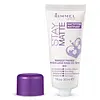What's inside
What's inside
 Key Ingredients
Key Ingredients

 Benefits
Benefits

 Concerns
Concerns

 Ingredients Side-by-side
Ingredients Side-by-side

Water
Skin ConditioningCyclopentasiloxane
EmollientTalc
AbrasiveCetyl PEG/PPG-10/1 Dimethicone
EmulsifyingAluminum Starch Octenylsuccinate
AbsorbentPropylene Glycol
HumectantVinyl Dimethicone/Methicone Silsesquioxane Crosspolymer
Isononyl Isononanoate
EmollientPolypropylene
Silica
AbrasiveSilica Dimethyl Silylate
EmollientDisteardimonium Hectorite
StabilisingMagnesium Sulfate
Bis-PEG/PPG-14/14 Dimethicone
EmollientGlycerin
HumectantLaureth-7
EmulsifyingTribehenin
EmollientXanthan Gum
EmulsifyingPhenoxyethanol
PreservativePropylene Carbonate
SolventSorbitan Sesquioleate
EmulsifyingChlorphenesin
AntimicrobialTocopheryl Acetate
AntioxidantDisodium EDTA
Triethoxycaprylylsilane
Pentaerythrityl Tetra-Di-T-Butyl Hydroxyhydrocinnamate
AntioxidantCI 77891
Cosmetic ColorantWater, Cyclopentasiloxane, Talc, Cetyl PEG/PPG-10/1 Dimethicone, Aluminum Starch Octenylsuccinate, Propylene Glycol, Vinyl Dimethicone/Methicone Silsesquioxane Crosspolymer, Isononyl Isononanoate, Polypropylene, Silica, Silica Dimethyl Silylate, Disteardimonium Hectorite, Magnesium Sulfate, Bis-PEG/PPG-14/14 Dimethicone, Glycerin, Laureth-7, Tribehenin, Xanthan Gum, Phenoxyethanol, Propylene Carbonate, Sorbitan Sesquioleate, Chlorphenesin, Tocopheryl Acetate, Disodium EDTA, Triethoxycaprylylsilane, Pentaerythrityl Tetra-Di-T-Butyl Hydroxyhydrocinnamate, CI 77891
Water
Skin ConditioningCyclopentasiloxane
EmollientPolymethylsilsesquioxane
Dimethicone
EmollientCeresin
Emulsion StabilisingGlycerin
HumectantSilica
AbrasiveCapryloyl Glycine
CleansingLauryl PEG-10 Tris(Trimethylsiloxy)Silylethyl Dimethicone
EmulsifyingTrimethylsiloxysilicate
EmollientPropylene Glycol
HumectantHdi/Trimethylol Hexyllactone Crosspolymer
Sodium Chloride
MaskingAminomethyl Propanol
BufferingHydrogenated Polyisobutene
EmollientDimethicone/PEG-10/15 Crosspolymer
Dimethicone Crosspolymer
Emulsion StabilisingKaolin
AbrasiveCharcoal Powder
AbrasiveDisodium EDTA
Triethoxycaprylylsilane
Alumina
AbrasiveOryza Sativa Bran Wax
Skin ConditioningPhenoxyethanol
PreservativeEthylhexylglycerin
Skin ConditioningCI 77891
Cosmetic ColorantWater, Cyclopentasiloxane, Polymethylsilsesquioxane, Dimethicone, Ceresin, Glycerin, Silica, Capryloyl Glycine, Lauryl PEG-10 Tris(Trimethylsiloxy)Silylethyl Dimethicone, Trimethylsiloxysilicate, Propylene Glycol, Hdi/Trimethylol Hexyllactone Crosspolymer, Sodium Chloride, Aminomethyl Propanol, Hydrogenated Polyisobutene, Dimethicone/PEG-10/15 Crosspolymer, Dimethicone Crosspolymer, Kaolin, Charcoal Powder, Disodium EDTA, Triethoxycaprylylsilane, Alumina, Oryza Sativa Bran Wax, Phenoxyethanol, Ethylhexylglycerin, CI 77891
Ingredients Explained
These ingredients are found in both products.
Ingredients higher up in an ingredient list are typically present in a larger amount.
Ci 77891 is a white pigment from Titanium dioxide. It is naturally found in minerals such as rutile and ilmenite.
It's main function is to add a white color to cosmetics. It can also be mixed with other colors to create different shades.
Ci 77891 is commonly found in sunscreens due to its ability to block UV rays.
Learn more about CI 77891Cyclopentasiloxane, or D5, is a silicone used to improve texture of products and trap moisture.
D5 is considered lightweight and volatile. Volatile means it evaporates quickly after application. Once evaporated, D5 leaves a thin barrier that helps keep skin hydrated.
It is also an emollient. Emollients help soften the skin and prevent water loss. Silicones create a silky texture in products. D5 helps other ingredients become more spreadable.
Studies show D5 is safe to use in skincare products. We recommend speaking with a skincare professional if you have concerns.
Learn more about CyclopentasiloxaneDisodium EDTA plays a role in making products more stable by aiding other preservatives.
It is a chelating agent, meaning it neutralizes metal ions that may be found in a product.
Disodium EDTA is a salt of edetic acid and is found to be safe in cosmetic ingredients.
Learn more about Disodium EDTAGlycerin is already naturally found in your skin. It helps moisturize and protect your skin.
A study from 2016 found glycerin to be more effective as a humectant than AHAs and hyaluronic acid.
As a humectant, it helps the skin stay hydrated by pulling moisture to your skin. The low molecular weight of glycerin allows it to pull moisture into the deeper layers of your skin.
Hydrated skin improves your skin barrier; Your skin barrier helps protect against irritants and bacteria.
Glycerin has also been found to have antimicrobial and antiviral properties. Due to these properties, glycerin is often used in wound and burn treatments.
In cosmetics, glycerin is usually derived from plants such as soybean or palm. However, it can also be sourced from animals, such as tallow or animal fat.
This ingredient is organic, colorless, odorless, and non-toxic.
Glycerin is the name for this ingredient in American English. British English uses Glycerol/Glycerine.
Learn more about GlycerinPhenoxyethanol is a preservative that has germicide, antimicrobial, and aromatic properties. Studies show that phenoxyethanol can prevent microbial growth. By itself, it has a scent that is similar to that of a rose.
It's often used in formulations along with Caprylyl Glycol to preserve the shelf life of products.
Propylene Glycol is an odorless, colorless liquid. As a humectant, it helps skin retain moisture. It also aids in delivering active ingredients.
Another role of this ingredient is preventing a product from melting or freezing. Propylene glycol also adds antimicrobrial properties to a product, elongating product lifespan.
This ingredient is considered an organic alcohol and commonly added into both cosmetics and foods.
Those with sensitive skin or conditions may develop a rash when using this ingredient.
Learn more about Propylene GlycolSilica, also known as silicon dioxide, is a naturally occurring mineral. It is used as a fine, spherical, and porous powder in cosmetics.
Though it has exfoliant properties, the function of silica varies depending on the product.
The unique structure of silica enhances the spreadability and adds smoothness, making it a great texture enhancer.
It is also used as an active carrier, emulsifier, and mattifier due to its ability to absorb excess oil.
In some products, tiny microneedles called spicules are made from silica or hydrolyzed sponge. When you rub them in, they lightly polish away dead skin layers and enhance the penetration of active ingredients.
Learn more about SilicaTriethoxycaprylylsilane is a silicone used to bind and stabilize ingredients.
As an emulsifier, it helps prevent ingredients from separating. This can help elongate the shelf life of products.
Triethoxycaprylylsilane is often used to coat mineral sunscreens ingredients to help give a better feel. It also helps reduce oxidative stress in sunscreens.
Learn more about TriethoxycaprylylsilaneWater. It's the most common cosmetic ingredient of all. You'll usually see it at the top of ingredient lists, meaning that it makes up the largest part of the product.
So why is it so popular? Water most often acts as a solvent - this means that it helps dissolve other ingredients into the formulation.
You'll also recognize water as that liquid we all need to stay alive. If you see this, drink a glass of water. Stay hydrated!
Learn more about Water